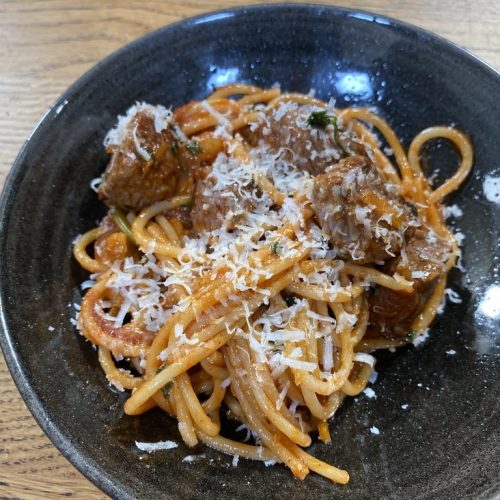Welcome to my personal journey of mastering the art of spaghetti ragout! As an food easy recipes enthusiast, I have always been captivated by the rich flavors and comforting aromas of this classic Italian dish. In this blog, I will take you through five easy steps to create a flavorful spaghetti ragout that will leave your taste buds craving for more. From the slow-simmering process to exploring the versatile uses of ragout, and finally, serving tips and ideas for a delicious meal, I am excited to share my experiences and insights with you. So, grab your apron and let’s embark on this culinary adventure together!
5 Easy Steps to Create a Flavorful Spaghetti Ragout
Creating a flavorful spaghetti ragout doesn’t have to be difficult. By following these 5 easy steps, you can create a delicious and satisfying dish that will impress your dinner guests.
- First, gather your ingredients. You will need spaghetti, extra-virgin olive oil, ground beef chuck, sweet Italian sausages, garlic, onions, carrots, celery, canned tomatoes, tomato paste, red wine, dried basil, dried oregano, salt, and pepper. These ingredients can be easily found at your local grocery store.
- Next, heat a large pot over medium heat and add a drizzle of olive oil. Once the oil is hot, add the ground beef chuck and sweet Italian sausages. Break them up with a wooden spoon and cook until browned. This will help to develop the rich flavors of your ragout.
- Once the meat is browned, add the garlic, onions, carrots, and celery to the pot. Cook until the vegetables are soft and fragrant. This will add depth and sweetness to your ragout.
- Next, add the canned tomatoes, tomato paste, red wine, dried basil, dried oregano, salt, and pepper to the pot. Stir everything together and bring the mixture to a simmer. Reduce the heat to low and let the ragout simmer for at least 1 hour, but longer if possible. This slow-simmering process will allow the flavors to meld together and create a rich and hearty sauce.
- While the ragout is simmering, cook your spaghetti according to the package instructions. It’s important to cook the spaghetti al dente, which means it should still have a slight bite to it. This will ensure the perfect texture for your ragout.
- Once the ragout has finished simmering and the spaghetti is cooked, it’s time to serve your flavorful spaghetti ragout. Drain the spaghetti and divide it among plates. Ladle the ragout over the spaghetti and garnish with a sprinkle of freshly grated Parmesan cheese. This will add a burst of flavor and richness to your dish.
To complete the meal, pair your spaghetti ragout with a glass of your favorite red wine. The flavors of the ragout and the wine will complement each other perfectly and enhance your dining experience.

Spaghetti ragout
Ingredients
- 750 gr. spaghetti No. 6
- 300 gr. minced beef and
- 200 gr. pork
- 2 large onions
- chopped
- 3.4 tbsp tomato paste
- 1 cup. beef broth or 1 / 2 cube dissolved in 1 cup. water.
- 1 carrot trimmed and last in the grater
- 2.3 pieces of celery depending on size chopped
- 2 cloves garlic chopped
- 125 ml red wine
- 1 bay leaf
- 1 cinnamon spill
- 40 gr. chopped parsley
- Salt and freshly ground pepper
Instructions
- In a pan with some oil and saute onion garlic.
- Add minced meat and stir two to three λεπτά sauté until and whitens. Pour the wine and stir until it evaporates completely.
- You put the tomato paste and 1 cup. beef broth, carrot and the celery and lower the heat by half, to simmer. Leave at least 20 minutes.
- Put the bay leaves, cinnamon and salt and pepper and allow sauce to boil for 3 minutes, stirring at intervals.
- Finally add the parsley and tested.
- In a saucepan boil 1 liter of water with 25 gr. salt and add the pasta, leaving them for 7,5-8 minutes. The drain and mix with the sauce.
- Serve with grated Parmesan.
Video
Notes
Mastering the Art of Slow-Simmered Ragu: A Homestyle Approach
Once you have mastered the art of slow-simmered ragu, you will be able to enjoy a homestyle approach to this traditional Italian dish. Slow-simmered ragu is a labor of love that requires time and patience to perfect. The slow cooking process allows the flavors to develop and meld together, resulting in a rich and flavorful sauce that will elevate any pasta dish.
To achieve the best results, it is important to start with fresh, high-quality ingredients. Choosing the right cuts of meat, such as beef or pork, is crucial for a delicious ragu. These meats provide the base for the sauce and will add depth and complexity to the final dish. Properly browning the meat is also key to enhancing the flavor of the ragu.
Aromatics, such as onions, garlic, and herbs, play a significant role in enhancing the taste of the ragu. These ingredients add layers of flavor and aromas that will make your mouth water. Additionally, using a combination of tomato paste and crushed tomatoes will give your ragu a robust and balanced sauce.
One of the defining characteristics of slow-simmered ragu is the length of cooking time required. It may take several hours for the flavors to fully develop and the sauce to thicken. However, the wait is well worth it, as the end result will be a deeply flavorful and satisfying ragu.
Adjusting the seasoning and acidity of the ragu to suit personal preferences is another important aspect of mastering the art of slow-simmered ragu. Adding salt, pepper, and other spices can enhance the flavors, while adjusting the acidity with a splash of red wine or a touch of sugar can balance out the sauce.
Once your slow-simmered ragu is ready, it can be enjoyed in a variety of ways. Pair it with the perfect pasta, such as spaghetti or tagliatelle, for a classic and comforting meal. Alternatively, use it as a filling for lasagna or stuffed peppers for a delicious twist on traditional dishes. The versatility of ragu allows for endless culinary possibilities.
Versatile Meat Sauce: Exploring the Many Uses of Spaghetti Ragout
In the previous section, we delved into the comforting and versatile nature of meat sauce, specifically spaghetti ragout. The author beautifully described the process of creating a rich and flavorful sauce, starting with browning the meat and adding a medley of vegetables and aromatic ingredients. This classic base can then be transformed into various iterations, each offering a unique dining experience.
One of the joys of working with meat sauce is the ability to customize it according to individual preferences. Whether you prefer a hearty ragù with a combination of pork, beef, and veal, or a simpler version with just ground beef and tomatoes, the possibilities are endless. The author’s personal experience and love for meat sauce adds credibility to their exploration of its uses, making it even more enticing for readers to try these variations themselves.
But meat sauce is more than just a delicious accompaniment to pasta. It has the power to transport us to different places and evoke nostalgic memories. The author mentioned how their homemade ragout, when tossed with al dente rigatoni and a velvety drizzle of olive oil, takes them to the serene dining rooms of Chicago’s finest Italian restaurants. On the other hand, a plate of oil-glossed spaghetti noodles topped with a thick layer of meaty paste brings them back to the candlelit dining room of their favorite Italian-American eatery. The versatility of meat sauce allows us to create these culinary journeys in our own kitchens.
Exploring the many variations of meat sauce can add excitement and variety to our meals. From bolognese-style sauces perfect for lasagna or moussaka, to homemade ragouts bursting with authentic Italian flavors, there is always something new to discover. The author’s description of their favorite $16 spaghetti with extra meat sauce since childhood creates a sense of familiarity and connection for readers. It reminds us of the simple pleasure of enjoying a comforting dish that has been a constant in our lives.
So why not embark on your own meat sauce adventure? Try different ingredients, experiment with flavors, and let your imagination run wild. Use it with different types of pasta or as a topping for other dishes. The versatility of meat sauce knows no bounds, and it’s up to us to explore its many delicious possibilities.
How to Serve Spaghetti Ragout: Tips and Ideas for a Delicious Meal
Spaghetti ragout is a classic Italian dish that is both delicious and satisfying. With a few tips and ideas, you can create a mouthwatering meal that will leave you craving for more.
When it comes to choosing the best beef cut for ragout, inexpensive braising or stewing steak is the way to go. This cut, often known as chuck steak, comes from the forequarter and is packed with flavor. It may be tough, but with long, slow cooking, it becomes tender and adds richness to the dish.
To enhance the flavors of the ragout, a cheap red wine such as merlot, malbec, or shiraz can be used. However, if you prefer not to use alcohol, you can simply omit it and add a little extra stock for moisture.
To start making the ragout, coat the beef in flour, salt, and pepper before browning it in a pan with oil. This step adds an extra layer of flavor and helps with browning. Finely chopped onions, carrots, celery, and garlic are then added to the pan to soften and infuse their flavors into the ragout.
Next, tomato puree and red wine are added to create a rich and flavorful sauce. Be sure to scrape off any bits that have stuck to the bottom of the pan as they are full of flavor. Tinned tomatoes, beef stock, and thyme are also added to the pan before transferring it to the oven for 3-4 hours of slow cooking. This allows the beef to become tender and the flavors to meld together beautifully.
Once the ragout is cooked, give it a good stir and serve it up with your favorite pasta. A pro tip is to dunk the pasta in the sauce in the casserole dish first to coat it in that rich sauce, then transfer the pasta to a bowl and spoon more sauce and meat on top. Finish off with a sprinkling of parsley and parmesan for added freshness and flavor.
If you’re looking for more Italian-inspired recipes, there are plenty to explore. From lasagne to moussaka, the versatile meat sauce can be used in a variety of dishes. Whether you prefer a homemade ragout or a prepared jar sauce, you can create a flavorful and satisfying meal that will satisfy your pasta cravings.
In the next section, we will delve into more cooking tips and tricks for making the perfect spaghetti ragout. Stay tuned for more delicious ideas!
To Wrap Things Up
As we come to the end of this personal journey of mastering the art of spaghetti ragout, I hope you have found inspiration and confidence to create your own flavorful masterpiece. Remember, the key lies in the slow-simmering process and the use of quality ingredients. Whether you choose to use it as a sauce for spaghetti or explore its versatility in other dishes, spaghetti ragout is sure to bring joy and satisfaction to your dining table. So, go ahead and experiment with different flavors and techniques, and don’t be afraid to make it your own. Thank you for joining me on this culinary adventure, and may your future ragout creations be filled with deliciousness and culinary triumph!





